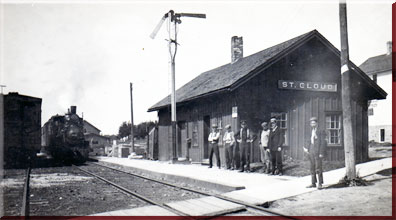St. Cloud Bulletin Board
NEW - Public space use permit application is to be used by individuals or organizations wishing to place structures or objects on Village property and other public spaces. See more infomation on application.
Public space use permit application
History of St. Cloud
St Cloud is part of the “Holyland”. The village and surrounding area were settled by close-knit, agricultural, Roman Catholic, German settlers in the 1840’s. This was an example of chain migration which is the process of a few foreign immigrant pioneers settling in a new area, then getting word back home encouraging other family members to settle in the new area also.
The village was surveyed with streets, blocks and lots and a right-of-way for the Sheboygan and Fond du Lac railroad in 1869 by Henry Moersch.  The railroad operated from Fond du Lac to Sheboygan from 1870 to 1952 and provided freight and passenger service to the village. In 1908 plans were made to have the village incorporated. An election was held on Thursday March 4, 1909 to determine if incorporation was wanted. 79 ballots were cast; 42 “yes” and 37 “no”.
The railroad operated from Fond du Lac to Sheboygan from 1870 to 1952 and provided freight and passenger service to the village. In 1908 plans were made to have the village incorporated. An election was held on Thursday March 4, 1909 to determine if incorporation was wanted. 79 ballots were cast; 42 “yes” and 37 “no”.
The village was a bustling little community at the turn of the century. The slogan at that time was optimistic, “St Cloud, the city of tomorrow”. In 1920 the population was around 400. The population eventually reached 500 and has stabilized there.
The Catholic Church was an important part of the community. John Pauly called a meeting at Jacob Schoenborn’s house with 28 families attending and formed the parish. They elected Pauly president in fall of 1869. A four-acre parcel was donated by Henry Moersch for the future church buildings. A church was soon built without authorization of the bishop. After some misgivings, the bishop finally approved the new church and it was dedicated in February 1871. Priests from Johnsburg and St. Anna served the new parish via horse and buggy until 1922 when a resident priest was assigned to the parish. The first resident diocesan priest was Father Stephen Zohlen and served here until June 1951. The Sisters of St Agnes started teaching in 1875 at the one room school house which was built in 1871. The first teaching nun was Sister M. Engelberta.
